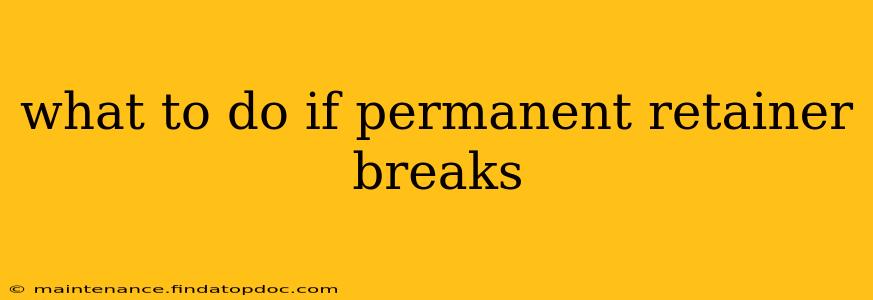A broken permanent retainer is a frustrating situation, but don't panic! Knowing what to do can minimize discomfort and prevent further dental problems. This guide will walk you through the steps to take if your permanent retainer breaks, offering advice on temporary fixes and when to seek professional help.
What is a Permanent Retainer?
Before diving into solutions, let's quickly understand what a permanent retainer is. It's a thin wire cemented to the back of your teeth, usually the lower incisors (front teeth), to maintain the straightness achieved after orthodontic treatment (braces). They're designed to be a long-term solution, but they can break or become loose.
What Happens If My Permanent Retainer Breaks?
A broken retainer can lead to several issues:
- Teeth Shifting: This is the most significant concern. The retainer's primary purpose is to prevent your teeth from moving back to their original positions. A broken retainer loses this function, potentially causing teeth to shift and misalign.
- Discomfort: Sharp or loose wires can irritate your gums and cheeks, causing discomfort and potentially sores.
- Food Trapping: Broken segments of the retainer can create spaces where food can get trapped, leading to plaque buildup and potential gum disease.
How Can I Tell If My Permanent Retainer is Broken?
You'll likely notice something amiss if your retainer breaks. Common signs include:
- Sharp Wire: Feeling a poking or scratching sensation in your mouth.
- Loose Wire: A section of the retainer feels loose or wobbly.
- Broken Wire: A visible break or gap in the wire.
- Pain or Discomfort: Increased sensitivity or pain in your teeth or gums.
What Should I Do If My Permanent Retainer Breaks?
Immediate action is crucial. Here's a step-by-step guide:
- Rinse Your Mouth: Thoroughly rinse your mouth with warm salt water to clean the area and reduce irritation.
- Check for Sharp Wires: Carefully examine your retainer. If there are any sharp ends, try to gently push them down using a cotton swab or your fingernail (if possible and without causing further damage). Caution: Avoid using sharp objects that could injure your gums.
- Temporary Fix (If Possible): If a small portion is loose or has come off, you can try carefully using dental wax (available at most pharmacies) to temporarily secure the loose wire. This is only a temporary measure, not a long-term solution.
- Contact Your Orthodontist: This is the most important step. Schedule an appointment with your orthodontist or dentist as soon as possible. They are the best equipped to assess the situation and perform the necessary repair. Delaying this could lead to more significant tooth movement.
Can I Fix My Permanent Retainer Myself?
Generally, no. Attempting to fix a permanent retainer yourself can lead to further damage, potentially injuring your gums or teeth. Leave the repair to a professional. They have the right tools and expertise to safely and effectively fix or replace the retainer.
How Long Does it Take to Repair a Broken Permanent Retainer?
The repair time depends on the extent of the damage. It could be a quick fix during a short appointment, or it might require a more complex procedure. Your orthodontist will provide an accurate timeframe during your consultation.
How Much Does it Cost to Repair a Broken Permanent Retainer?
The cost varies depending on your location, the extent of the damage, and your insurance coverage. It's best to contact your orthodontist directly to get an estimate.
How Can I Prevent My Permanent Retainer From Breaking?
While breakage can occur unexpectedly, you can take steps to minimize the risk:
- Avoid Hard Foods: Steer clear of hard candies, ice, and other foods that could bend or break the wire.
- Good Oral Hygiene: Maintain meticulous oral hygiene by brushing and flossing regularly.
- Regular Checkups: Attend your scheduled checkups with your orthodontist for routine inspections and adjustments.
By following these tips and seeking professional help immediately if your permanent retainer breaks, you can protect your investment and maintain a healthy, beautiful smile. Remember, prevention is key and regular maintenance is crucial for the long-term success of your orthodontic treatment.
